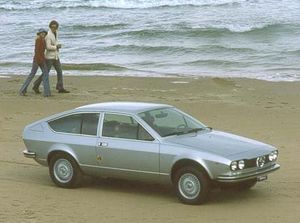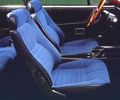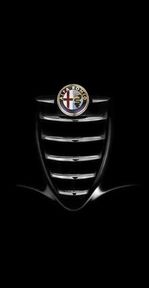.
Alfa Romeo Alfetta

| |
| Alfa Romeo Alfetta | |
|---|---|
| Alfa Romeo | |
| aka | Type aka here, not up there |
| Production | produced from when to when+total units made (optional) |
| Class | denote market class |
| Body Style | how many doors+how many seats+what type of body |
| Length | length - type here |
| Width | Width - type here |
| Height | Height - type here |
| Wheelbase | wheelbase - type here |
| Weight | Weight - you get the point |
| Transmission | transmission + drive |
| Engine | engine |
| Power | N/A hp @ N/A rpm N/A lb-ft of torque @ N/A rpm |
| Similar | similar (competition) |
| Designer | Designer (lead designer if it was a team effort) |
The Alfa Romeo Alfetta was an executive saloon car and fastback coupé produced from 1972 until 1984 by Alfa Romeo. It was popular due to its combination of a modest design with powerful engines, selling over 400,000 units until the end of its production run, but in the final years its sales were down due to Alfa Romeo's reliability problems that plagued the company through the late 1970s and early 1980s.
The Sedan had a body designed by Nuccio Bertone, and the coupe (later Alfa Romeo GTV, was designed by Giorgetto Giugiaro, the Alfetta introduced a new drivetrain layout to the marque. Clutch and transmission were housed at the rear of the car, together with the differential for a more balanced weight distribution, as used on the Alfetta 158/159 Grand Prix cars. The suspension relied on double wishbones and torsion bars at the front and a de Dion beam at the rear. The Alfetta was renewed in 1979 with a revised frontend, new wheel rims and new lights, as well as a Diesel version.
It was available with two four-cylinder DOHC engines with two valves per cylinder and a turbo Diesel engine supplied by VM Motori. The 1.6 and 1.8 L base models had two double-barrel carburettors, while the 2.0 DOHC received fuel injection in 1979. The Diesel initially had 2.0 L, but was increased to 2.4 L in 1982.
The four-door Alfetta was sold in the USA from 1975 through 1981 under the name Alfa Romeo Sports Sedan; the four-cylinder coupe was available from 1975 to 1980 under the moniker Alfa Romeo Sprint Veloce GT, the V-6 version being marketed from 1981 to 1986 as the GTV-6.
The Alfa Romeo Alfetta became well known throughout the world since it was Italian Prime Minister Aldo Moro's official escort car, when, in 1978, he was first kidnapped, then killed, by the Italian Terrorist left-wing organization The Red Brigades. A fictionalised account of these events was produced as a critically well regarded Italian film , The Advocate, which also heavily featured Alfettas of all types, from Carabieneri 'Short Nose-Round Light' through to the Prime Minister's own 'Long Nose-Square Light' 2000 Super Saloon.
Design and dynamics
The rear transaxle found on the Alfetta and derivatives- GTV, 90 and 75- provided these cars with excellent weight distribution. This resulted in excellent handling, which some experts believe makes these some of the best-handling cars of their time. Unlike most rear-wheel drive cars, the transaxle meant there was no transmission tunnel between the front seats, thus helping interior space.
GT, GTV and GTV6
For information about the Current model GTV see Alfa Romeo GTV & Spider
The Alfetta was the base for the GTV, a fastback coupé version of the saloon, introduced in 1974 as Alfetta GT, initially available only with the 1.8 litre (1779cc) version of the Alfa DOHC four. For 1976, with the final phasing out of the earlier 105 Series 1.3 and 1.6 litre coupes (GT 1300 Junior and GT 1600 Junior) and the 2.0 litre 105 series 2000 GTV, the Alfetta GT became a range, also available with the 1.6 litre (1570cc) and 2.0 litre (1962cc) versions of the same engine as the Alfetta GT 1.6, Alfetta GT 1.8 and Alfetta GTV 2000. The GTV designation was initially reserved for the 2.0 litre top version.
In 1979, some minor revisions, including a revised engine with new camshaft profiles and a change to mechanical-and-vacuum ignition advance, saw the 2.0 litre redesignated the Alfetta GTV 2000L. Autodelta also produced a limited edition turbocharged model, named Turbodelta, for FIA Group 4 homologation. This version used a KKK turbo which pushed power up to 175 PS (129 kW). The car also received a modified suspension layout.
In 1981, the GTV received a restyling, with grey plastic bumpers and all matt-black trim replacing bright stainless steel, the 1.6 litre and 1.8 litre versions were discontinued and the Alfetta 2000 GTV became the base coupé model as the Alfa GTV 2.0. The Alfetta name was dropped, but the two-litre coupé retained its type designation of 11636 for left hand drive and 11637 for right hand drive. 15 inch alloy wheels were now standard, as opposed to the earlier cars' 14 inch pressed steel or optional 14 inch alloy.
Later in the same year, the GTV-6, a version of the GTV with the SOHC V6 2.5 L engine from the Alfa 6 luxury sedan, was released. As a result the hood received a bulge to clear the top of the intake and became its most pronounced feature. With Bosch fuel injection instead of the six downdraught Dellorto carburettors in the early Alfa 6 installation, the V6 was much easier to start and retained its state of tune much better. The V6 received rave reviews from the motoring press, which had previously lambasted the same engine in the Alfa 6 because of the carburettor problems. It found its true home in the GTV-6 where it could stretch its legs better than in the less sporting Alfa 6 sedan, including winning the European Touring Car Championship an unprecedented four years in succession (1982-85), the British Touring Car Championship in 1983 at the hands of Andy Rouse, as well as many other racing and rallying competitions. The fuel injection installation eventually made it into the second series of the Alfa 6 as well. The GTV went through a number of revisions, including a new gear ratios and an updated interior in 1984.
South African models were first assembled at Automaker's Rosslyn plant, located outside Pretoria. These early, 1973 models, were manufactured alongside Datsuns. From 1974 South African Alfetta's were manufactured at Alfa Romeo's own Brits plant. South Africa was one of two markets to have a turbocharged GTV6, with a Garrett turbocharger and a NACA intake. An estimated 750 were assembled before all production ceased in 1986. The South African market also introduced the 3.0 L GTV-6, predating the international debut of the factory's 3.0 L engine in 1987. Approximately 200 were built in South Africa for racing homologation. To this day, the GTV-6 remains the quintessential Alfa Romeo for South Africans.
Reeves Callaway, founder of Callaway Cars and famous for his various modifications of Chevrolet Camaros and Corvettes, modified about thirty GTV-6s to Callaway Twin Turbo specification for Alfa Romeo Inc., the North American importer. Also see the twin turbo gtv6 from australia (alfauto) www.italianautoclub.com from www.alfauto.com.au
Alfetta GT and GTV Racing Versions by Autodelta
Racing versions of the Alfetta GT and GTV were built by Autodelta, initially with the normally aspirated engine from the earlier GTAm racer based on the 105 series coupe, for homologation under FIA Group 2. In this form they were rallied with moderate success in 1975, winning the Elba and Costa Brava rallies overall, as well as winning the Group 2 category in the World Rally Championship's Corsican event. The next year Autodelta shifted its focus to circuit racing the Alfettas, which won the under 2.5-liter Group 2 division of the European Touring Car Championship, scoring a remarkable second place overall at the 24 hour race at Spa-Francorchamps, as well as an overall win in the ETC race at Vallelunga. Despite such results, Autodelta's efforts with the Group 2 Alfetta were desultory, and ended prematurely. At a single rally at the end of the 1975 season, Autodelta also rallied an Alfetta GTV with a 3.0 litre V8 engine, derived from the 2.6 litre V8 of the Alfa Romeo Montreal coupé and sharing the same mechanical fuel injection by Spica. It had been suggested to produce 400 roadgoing versions of this model for homologation but this plan was abandoned as well.
In 1980 the Alfetta GTV Turbodelta was already homologated in FIA Group 4, since the required number of production cars had been built. A racing version was campaigned in rallies, but once more the effort was abandoned after a single season, despite scoring a win at the Danube Rally.
Gallery
Trivia
- A grey GTV6 is featured for a short period in the James Bond movie Octopussy. Bond steals the parked car while its owner uses a pay phone booth and makes haste towards Octopussy's Circus.





